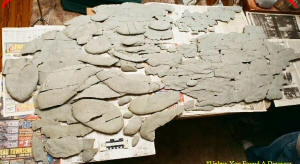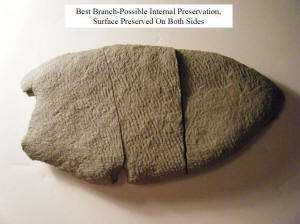

Stop here occasionally for updates on the status and activities of the identification and description of Ron Fine's mystery fossil, code named "Godzillus."
THE LATEST ON "GODZILLUS"
A professional paper about the "Godzillus" fossil in now featured in the October
2016 issue of Palaios.
Dr. David Meyer of the University of Cincinnati along with
the finder of
Godzillus, Ron Fine, and co-authors Dr. Carton Brett and Dr. Benjamin Dattilo
wrote the paper. The title is
INVERTED
TRILOBITES: KEY TO COMPLEX PRESERVATION OF AN ORGANICALLY TEXTURED SURFACE IN
OFFSHORE SILICICLASTIC MUDSTONE AND CARBONATE FACIES: KOPE FORMATION (UPPER
ORDOVICIAN), KENTON COUNTY, KENTUCKY, USA
Dr. David Meyer of the University of Cincinnati spoke about Godzillus and answered questions on Sunday, May 4, 2014 during our fossil show, Geofair. The talk was titled "A Major Mystery Fossil Discovery from Cincinnati's Ordovician Rocks."
On the lighter side, the "Godzillus" fossil has now been named number 6 in the top 10 Discoveries Unexplained by Science on the "Alltime10s" channel on Youtube. (http://www.youtube.com/watch?v=Ug7AaJjwBDA)
BACKGROUND
Seldom does Amateur Paleontology get any better than this. It's the kind of stuff of which all fossil hunters dream.
Dry Dredgers member Ron Fine was out for a typical fossil hunt at one of his favorite sites in northern Kentucky. A site he had been visiting many times before. But this time was different. He spotted an odd texture on a nodule of shale that he had not seen before. Ron had been fossil hunting all his life and knew this fossil was something totally different from any common fossil. His experience told him this was a great find.
Ron found more and more pieces of this same fossil where the first one was found. He spent all summer at that site, carefully recording the position of each fragment in situ and then removing them to take home. At home, he reassembled the fragments to find this fossil was of humongous proportions - three and a half feet wide and six and a half feet long. Most Late Ordovician fossils from the area are a few centimeters long.


See more photos of the individual segments of Godzillus.
Ron found this entire assemblage in a layer of the Southgate member of the Kope formation in Northern Kentucky near Cincinnati Ohio. The rocks exposed on this site are 450 million years old. The fossils were alive during the late Ordovician Period. The average size of fossils in the Kope formation is about the size of a thumbnail. So this is an extremely large plant or animal for its time and place.
Ron brought his find to the Dry Dredgers meeting. Lots of professional and amateur paleontologists examined the reassembled fragments in detail. Everyone agreed it was something they had never seen.
Renouned Miami Univ. Professor and previous Dry Dredgers president John Pope
takes a first look at the "new" fossil.
Our UC club advisor, Dr. David Meyer
and UC sedimentologist Dr.
Carlton Brett took on the project of finding an identity for what appears to be
the largest fossil ever found in the late Ordovician type-Cincinnatian formations.
Here (above) is Dr. David Meyer and Dr. Carlton Brett meeting with the press to explain what Ron
Fine has found.
Ron Fine, Dr. Meyer and Dr Brett prepared a poster for the 2012 meeting of the Geologic Society of America (GSA).
In the first photo below, Ron Fine, stands beside the poster
describing his interesting fossil find at the GSA meeting. In the second photo
below, Dr. David Meyer and other GSA attendees discuss the implications of Ron's
find.
Godzillus was one of the main attractions at
Geofair 2012,
Cincinnati's premier Gem, Mineral, Fossil and Jewelry Show..
Above: Ron Fine standing by his display of the Godzillus
mystery fossil at Geofair 2012.
At the April 2012 70th Anniversary
meeting of Dry Dredgers, Ron Fine was presented with a copy of the
Cincinnati Enquirer front page article about Godzillus. Ron also sported a copy
of the GSA meeting poster introducing Godzillus to the professional
paleontological community.
In timing with the Dry Dredgers' 70th Anniversary and the GSA meeting, public announcements of the discovery brought the news media from around the world in April 2012 to announce the huge find.
Since that time, "Godzillus" has gained worldwide fame. "Godzillus" is now defined on Wikipedia.
See Education Chair Greg Courtney's Video about "Godzillus."
Fine, R., C.E. Brett, B. Dattilo, and D.L. Meyer. 2012. An enigmatic lobate mat-like fossil(?) in the Kope Formation (Upper Ordovician), Kenton County, Kentucky. Geological Society of America Abstracts With Program 44(5), paper 24-10. [Abstract]
Meyer D, Brett C, Dattilo B, ORDOVICIAN TRILOBITES GETTING UNDER "DINOSAUR SKIN": COMPLEX PRESERVATION OF A MICROBIAL MAT (?) IN OFFSHORE SILICICLASTIC MUDSTONE AND CARBONATE FACIES: KOPE FORMATION (UPPER ORDOVICIAN), KENTON COUNTY, KENTUCKY, USA, 2013 GSA meeting, Paper No. 297-13, Read Abstract.
United States:
Interesting Articles:
Other Countries (each link a different country):
A note in the Dry Dredgers Bulletin inviting members to bring their summer fossil finds to the September meeting in 2011 resulted in the first look at Ron's new amazing monster fossil.
Dry Dredgers "The Bulletin", September 2011:
"Bring Your Summer Finds to the September Meeting"
by Bob Bross
Did you collect any unusual fossils over the summer? On a trip to a strange and exotic locale was an exciting paleontological find revealed? Perhaps you were cutting the grass, bent a lawnmower blade on a rock, and discovered it was a piece of limestone with a trilobite inside? While none of this may have happened to YOU, all of the above did occur (except for the trilobite part) with many of our members. Please bring your specimens to the September meeting to help share in the knowledge that is paleontology. At least one microscope will be in operation for a close-up look.
(NOW HERE IS THE FIRST PUBLIC MENTION OF RON FINE'S MYSTERY FOSSIL:)
Dry Dredgers "The Bulletin", October 2011, "What you missed at the last meeting:"
Ron Fine brought in a mudstone layer from one of his special Kope sites. The layer bore impressions that initially resembled small ripple marks. As Ron pointed out, upon closer examination, there appears to be some finely detailed structure within the larger pattern. Our resident professionals studied it closely and Ron has agreed to let them study it. Could this be an imprint of some previously unknown Cincinnatian organism??
Dry Dredgers "The Bulletin", November 2011, "What you missed at the last meeting:"
Ron fine covered the entire first row desk top with more pieces from his Kope mystery bio mat material. This was moved to UC�s labs for further study and joined the material Ron brought last month.
Dry Dredgers "The Bulletin", February 2012, "What you missed at the last meeting:"
Professor Dave Meyer announced that Dry Dredger Ron Fine is the senior author for a poster session at the upcoming GSA North-Central Section meeting in Dayton, Ohio April 23 and 24. Entitled: An Enigmatic Lobate Mat-like Fossil(?) In the Kope Formation (Upper Ordovician), Kenton County, Kentucky, the poster is based upon Ron�s new mystery fossil from the Kope that was displayed at recent meetings. This find may represent a biological mat heretofore not known from the Cincinnatian.
See more photos of the individual segments of Godzillus.
The Dry Dredgers and individual contributors reserve the
rights to all information, images, and content presented here. Permission to
reproduce in any fashion, must be requested in writing to admin@drydredgers.org.
www.drydredgers.org is designed and maintained by Bill Heimbrock.